Jackets with a synthetic winterizer are widespread among the consumer. They are light, bright and comfortable to wear, and the price will not allow to empty the wallet. In addition, these jackets are very warm and stylish. But sooner or later the question arises of their cleaning. The product becomes dirty and needs to be washed, and if you are not a fan of dry cleaners, you will have to do it yourself.
It is difficult and not necessary to wash a thing on a synthetic winterizer manually, it can be done in a washing machine. In this article we will talk in detail about all the nuances.
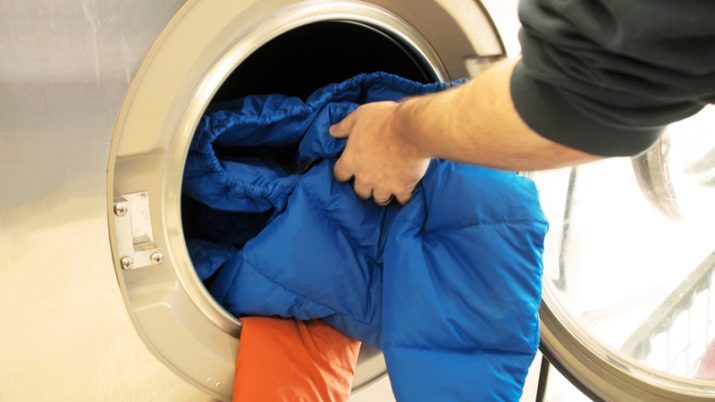
Features
A synthetic winterizer is a non-woven synthetic material used for insulation, which is inserted between the layers of the fabric of the product. In the process of machine washing, it can crumple, unevenly distributed, torn and clothes will lose their appearance. First you need examine the tag in which the manufacturer indicated the type of upper fabric, as well as the temperature regime in which washing is possible, the possibility or prohibition of spinning, ironing and other nuances.
Do not neglect this information, it will help to keep your thing in proper shape and not spoil it.

Legend:
- If you see a basin crossed out by two diagonal lines, then washing is excluded.
- In the case of exclusively hand-washing, a basin is depicted with the palm lowered into it.
- A rectangle with three vertical lines inscribed in it means a ban on spinning.
- A crossed out rectangle indicates a ban on machine drying.
- A straight line inscribed in a rectangle indicates that horizontal drying is allowed.
- A crossed out iron sign means no ironing.
- The crossed out triangle indicates a ban on chlorine-based detergents.
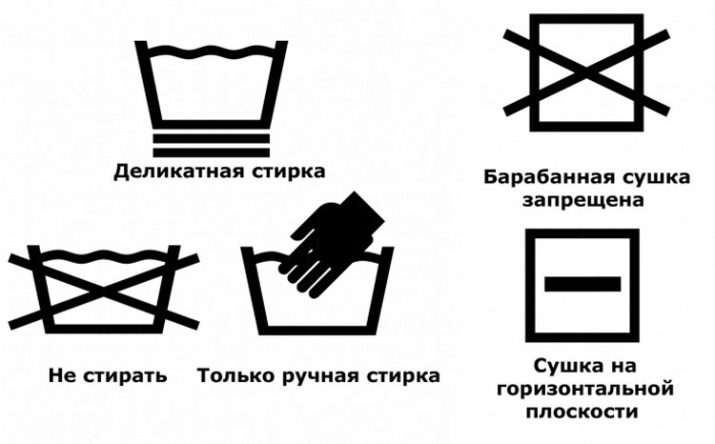
If you find that your jacket is covered with a membrane fabric, insulated with glued synthetic winterizer, contains non-removable parts made of genuine leather, wool or fur, then, alas, Machine wash is contraindicated. After a machine wash, your product may fade, sit down, warp, or stretch.
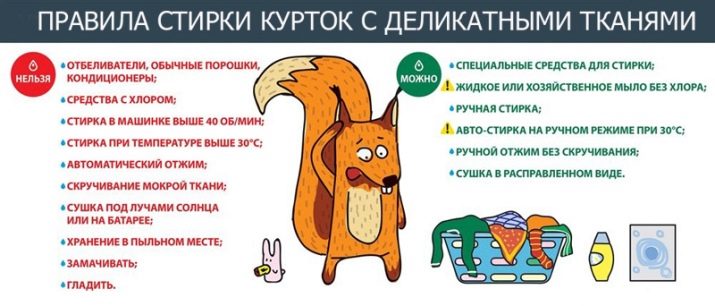
But do not rush to be upset. The jacket can be cleaned locally with a damp cloth and a small amount of Fairy type detergent. If there are spots and stains on such a jacket, then you can get rid of them with ammonia: we dilute 1 tablespoon of alcohol in 200 ml of water.

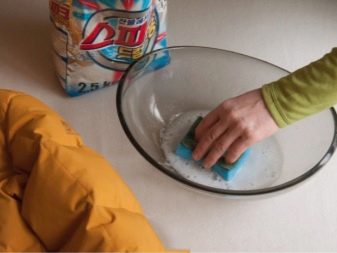
Handwash
First, consider the option of hand washing a sintepon jacket:
- Water temperature should not exceed 50 degrees. Ideally, it is better to stick to 30-40 degrees, this is guaranteed to protect your jacket from deformation. Fill a bathtub or large basin with water.
- Dilute a small amount of liquid detergent for gentle washing. It is better not to use washing powder, as it will dissolve poorly in non-hot water and stains may remain on the product. In addition, do not use bleaches.
- Dip your jacket in water and remember slightly, not much. It is important that the sintepon does not go astray and does not form lumps.
- If clothes are stained, clean them with a soft sponge and soap. Soak is not worth it, since the insulation can be damaged.
- Take out your jacket and change the water to clean. Rinse the product carefully, changing the water several times. It is important that detergents completely come out of their insulation.
- Gently squeeze the water out of the jacket, you can do this in an empty bathtub, pressing your palms on the product. Or hang the jacket on a hanger above the bathtub and gently squeeze the jacket from top to bottom, squeezing water out of it.
- Then you should spread a thick towel or terry sheet and lay out a jacket on it, checking if the insulation has shifted. When the clothes give away excess moisture to the fabric and partially dry, it can be hung to dry vertically.
In no case should you dry the jacket on the battery, this can ruin the product.
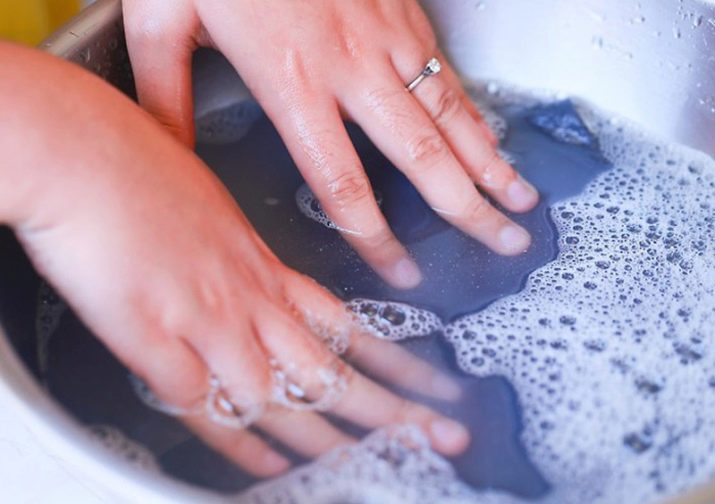
Machine wash
Preliminary preparation:
- To get started, carefully study the labels with the manufacturer's instructions. It is important to observe the temperature, spin and drying method.
- Unfasten the hood or collar from the jacket if they are trimmed with real fur. Or any removable fur decor with cuffs and hood. Remove the belt or belt.
- Check all pockets for keys, forgotten little things or small items.
- Check all product seams for integrity. Even the slightest divergence of the seam or slight surface damage during washing can turn into a huge hole, and even worse, filler can break out through the holes and the product will be hopelessly damaged. All damage must be carefully sewn.
- Zip all pockets and zippers on your jacket. If there are massive pendants or hanging accessories, it is better to remove or tie them to avoid damage.
- Before the main wash, pre-soap and wash the cuffs and collar. If there are stains and dirt, they must also be washed by hand, otherwise they may remain with the general washing and you will have to wash the product.
Stains from the foundation are easy to remove with medical alcohol. Grease stains can be easily removed with a dishwashing detergent, it gently acts and leaves no residue.
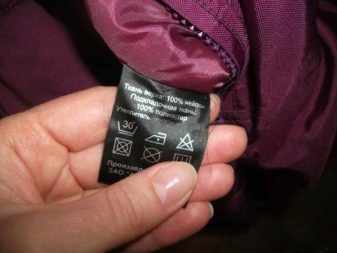

Procedure:
- Turn the jacket inside out and put it in the car. The product there should be one, it is better not to report anything, even if the drum seems empty to you. Putting the jacket should not be lumpy, but gently distributing. If you are afraid that the jacket might be damaged, load it into a special laundry bag.
- Instead of powder, choose a liquid detergent, it is well washed from the synthetic winterizer and does not leave stains on the surface of the product. It is good if the remedy is for delicate fabrics. In addition, the composition should not contain bleaching components or stain removers.
- Set the water temperature to 30-40 degrees. At higher temperatures, the item may become deformed.
- The washing mode is better to put “synthetics” or, if the machine allows, it is better to choose “hand” or “delicate washing”.
- For a more uniform washing, special balls for washing are laid in the drum, they gently smooth and beat the product, preventing the synthetic winterizer from falling into lumps. If you do not have such devices, some housewives recommend adding 3-4 balls to the drum. Next, start the wash.
- To guaranteed to avoid stains on the jacket, it is better to put an additional rinse.
- If spinning is allowed, it is necessary to set no more than 600 revolutions. Then we take out the jacket and, spreading it on a horizontal surface, pat it with a towel, this will speed up the drying time.
- In the case where the prohibition of spinning is indicated, after the washing is completed, we remove the jacket from the machine and, gently pressing, squeeze it in an empty bathroom. Then, as in the case of hand washing, dry it first horizontally, carefully straightening it. At the same time, carefully align the filler if it is strayed and deformed somewhere. In this case, towel blotting is also possible. And then we finish it on a hanger by hanging it on a rope or door.




Useful Tips
It is important to remember the basic rules. When washing a sintepon jacket it is forbidden:
- Apply powder and bleach.
- Wash at high temperatures.
- Squeeze, tightly twisting the product.
- Dry on batteries or in direct sunlight.
All the above recommendations apply equally to washing autumn, winter or demi-season clothes on a synthetic winterizer. The only exception exists for washing a white jacket.
It must first be soaked in a weak solution of detergent for a couple of hours.
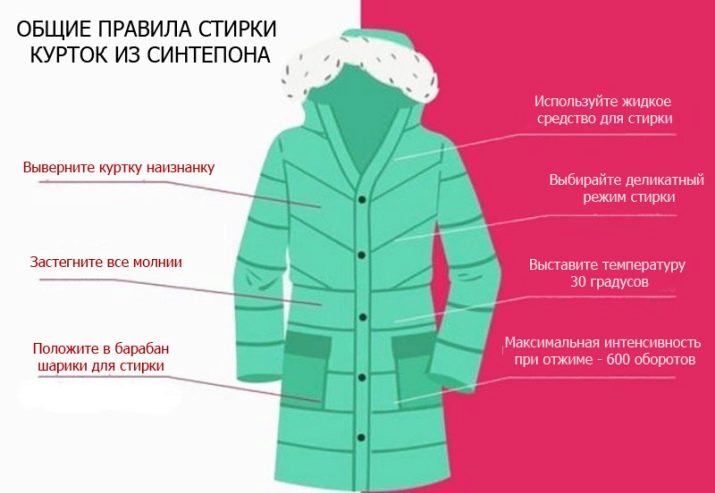
After complete drying, there are several methods to bring the jacket in proper form. Some fabrics are ironed, which is also indicated on the label. In this case, you need to iron the product through a cotton cloth or gauze, turning on the steaming mode. So, the synthetic winterizer will not additionally be pressed, and under the influence of steam it will fluff and return its volume.
It’s also nice to use steamerif available. The sintepon jacket should be washed 2-3 times a season correctly, avoiding strong pollution. So it will last a long time and keep an attractive appearance.
For more information on how to wash a jacket from a synthetic winterizer, see the next video.










